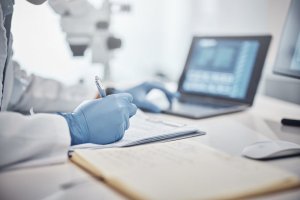You are here
What’s New in Organoid Research: 4 Publications by Researchers Pushing the Boundaries of What’s Possible

Founded nearly 30 years ago, Multi Channel Systems (MCS) is a pioneer in the development of commercially available microelectrode arrays (MEA) and their recording systems. MEAs have proven valuable for our understanding of how genetic background, disease pathology, and drugs alter neuronal network activity.
Organoid research has evolved rapidly, and offers unprecedented insights into cellular development, disease modeling, and regenerative medicine. A number of notable publications in organoid research have been released this year that provide insight into various biological and medical advancements.
These studies not only push the boundaries of what is scientifically achievable, but also open new avenues for understanding complex biological processes and advancing medical treatments. And products like Mesh MEA from Multi Channel Systems are advancing organoid electrophysiology to a point previously not attainable by allowing researchers to record data from inside an organoid without damaging its structure for the first time.
Below are four publications over the past few months that illustrate the diverse and rapidly evolving nature of organoid research.
1. "Biocomputing with Organoid Intelligence"
This article discusses the potential of integrating organoid models with artificial intelligence to enhance computing systems. It highlights advancements in using brain organoids to simulate neural processes and study complex phenomena like learning and sentience. The research suggests that organoid intelligence could play a role in future AI systems and biomedical technologies(Nature).
2. "Transformative Potential of 3D Bioprinting in Organoid Research"
Published in Organoid, this August 2024 article by Jungbin Yoon et al. explores the role of 3D bioprinting in advancing organoid research. The review emphasizes how bioprinting has helped generate complex, functional tissue structures and its impact on developing organoid models for drug testing and tissue regeneration(J-Organoid).
3. "Optical Coherence Tomography for Organoids"
This July 2024 review by Woo June Choi and Eun Seo Choi examines how optical coherence tomography (OCT) technology is revolutionizing 3D imaging of organoids. The application of OCT provides detailed imaging without disrupting organoid growth, enabling better observation of organ development and disease modeling(J-Organoid).
4. "Advances in Cardiac Organoid Technology"
Su-Jin Lee and Hyang-Ae Lee published this article in June 2024, highlighting trends in cardiac organoid research. Their work discusses the standardization of quality assessment for organoids used in toxicity testing and preclinical models, emphasizing the importance of consistency in organoid production for drug discovery(J-Organoid).
Â
References
Smirnova, L. (2024). Biocomputing with organoid intelligence. Nature Reviews Bioengineering, 2(8), 633–634. https://doi.org/10.1038/s44222-024-00200-6
Yoon, J., Yoon, G., & Jang, J. (2024). Transformative potential of three-dimensional bioprinting technology for advanced organoid research. Organoid, 4, e8. https://doi.org/10.51335/organoid.2024.4.e8
Choi, W. J., & Choi, E. S. (2024). Optical coherence tomography and its recent applications for three-dimensional imaging of organoids. Organoid, 4, e7. https://doi.org/10.51335/organoid.2024.4.e7
Lee, S. J., & Lee, H. A. (2024). Advances in cardiac organoid technology: Current trends and standardized quality assessment for toxicity testing in preclinical models. Organoid, 4, e6. https://doi.org/10.51335/organoid.2024.4.e6

